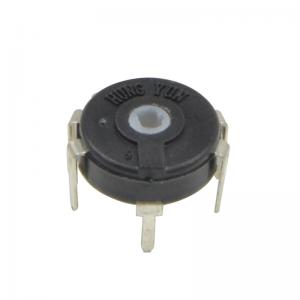

Add to Cart
7-pin PTK10 carbon composition rotary type potentiometer, rotary switch
Description:
A potentiometer can refer to two types of devices: an instrument
used to measure electromotive force, or an electronic component
with an adjustable resistance. In the latter case, a potentiometer
is generally a resistor with a sliding contact that is mounted on a
rotating shaft. This device serves as a voltage divider that allows
the user to alter the level of resistance offered to the current
flowing through it, which means that the output voltage can be
modified to anywhere between the maximum level of incoming current
and zero volts.
Carbon Potentiometer is an electronic component classified as
variable resistor. Carbon Potentiometer is used as voltage divider
to provide variable output voltage. Carbon Potentiometers uses
carbon as resistive element. There are also different types of
Potentiometers like Wire Wound type and ceramic type using
different materials on resistive element. Carbon Potentiometer can
be classified into logarithmic type and linear type depending on
the mode of operations. Carbon Potentiometers are of many types and
sizes depending on resistance value, power rating and type of
mounting.
Panel mounted type Carbon Potentiometer are widely used for volume
and tone control in consumer and entertainment electronics. PCB
mount type is used as function controller, measuring and testing
equipment, medical electronics, industrial electronics etc. Carbon
Potentiometer is available with and without switches. There are
also many varieties of spindles used for carbon potentiometer
depending on the materials and sizes.
Electrical specifications
| Range of value | 100Ω≤Rn≤5MΩ (Decad.1.0-2.0-2.2-2.5-4.7-5.0) |
| Tolerance | 100Ω≤Rn≤1MΩ ±20% ; 1MΩ≤Rn≤5MΩ ±30% |
| Max. voltage | 200 VDC(lin) 100VDC(no lin) |
| Rated power | 0.15W(lin) 0.07W(no lin) |
| Taper | lin; log; alog |
| Residual resistance | ≤5‰ Rn(3Ω min) |
| Equivalent noise resistance | ≤3% Rn(3Ω min) |
| Operating temperature | -25°C~70°C |
Others:
Rotation life: After 10,000 rotation, the changes impacted no more than ± (15% R +0.5 Ω ) rotational noise not more than 100 mv
Terminal strength: After welding (350 °C, 3,5 seconds) , the termination of terminal contacts should be good, no loosening of.
Soldering ability: Dip the terminals into tin tank at 260°C±5°C for 2±0.5 seconds, the soldering area should be more than 90%.
Resistance SR code table:
| Resistance | Code |
| 100Ω | 101 |
| 500Ω | 501 |
| 1KΩ | 102 |
| 2KΩ | 202 |
| 3.3KΩ | 332 |
| 4.7KΩ | 472 |
| 5KΩ | 502 |
| 10KΩ | 103 |
| 20KΩ | 203 |
| 22KΩ | 223 |
| 47KΩ | 473 |
| 50KΩ | 503 |
| 100KΩ | 104 |
| 200KΩ | 204 |
| 250KΩ | 254 |
| 500KΩ | 504 |
| 1MΩ | 105 |
| 2MΩ | 205 |
| 2.2MΩ | 225 |
Mounting methods:
Rotors available:
